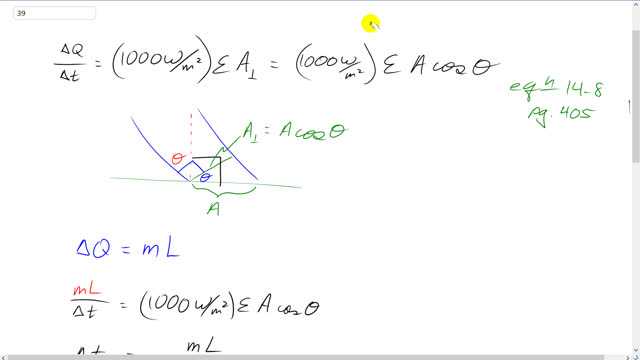
How long does it take the Sun to melt a block of ice at with a flat horizontal area and thickness 1.0 cm? Assume that the Sun’s rays make an angle of with the vertical and that the emissivity of ice is 0.050.

In order to watch this solution you need to have a subscription.
This is Giancoli Answers with Mr. Dychko. Here is the rate of heat transfer by radiation from the Sun. That's the solar constant, you know, on the ground, assuming that, you know, just a little bit is absorbed by the atmosphere on a clear day, it ends up having 1,000 watts per square meter on the ground times the emissivity of the earth times... Well, this is the emissivity of the ice block, I guess, yeah. And then times by the area of the ice block times cos θ, where θ is the angle of the Sun beam with respect to vertical, and to, you know, they don't, well, I guess, they do explain it but just to remind you of why it's area times cos θ, it's the area perpendicular to the Sun beam that we need. And this area perpendicular is the area here times cos θ because you can think of this triangle here, being a right triangle, right angle is here. And this area is like the hypotenuse of that triangle. And this is the component that's adjacent to θ. And this is θ here too in blue because, well, this is 90 degrees because, you know, by definition because we want this to be the surface perpendicular to the Sun beam. And if this is a, that makes this little bit in here, 90 minus θ. And that means this blue angle is the black 90 degree angle there minus this little portion. So, 90 minus 90 minus θ is θ. So, there. And it's adjacent, so, that means we use cosine multiplied-by the area here of the ice cube to get the perpendicular component of the area. So, that's a cos θ. So, all this heat energy absorbed is going into melting the ice. We assume that none of the energy goes into increasing the temperature of the water that results from the ice melting. It just all goes into melting the ice. And so we substitute mass times the latent heat of fusion in for Q. And we can solve this for t. Multiply both sides by Δt and then divide both sides by this. And you end up with t equals mL over 1,000 times emissivity times area times cos θ. And the mass of the ice cube is going to be its area times its thickness times the density. That's the mass per volume. And so now we see that the area actually cancels. And so now we have the thickness of the ice cube times density of water, or, sorry, density of the ice I should say, times latent heat of fusion divided by 1,000 times emissivity times cos θ. So, that's 0.01 meters times 0.917 times 10 to the 3 kilograms per cubic meter density of ice times 333 times 10 to the 3 joules per kilogram, latent heat of fusion, divided by 1,000 watts per square meter times 0.05 and then times cos 35. And that's going to be this many seconds and we convert that to hours by multiplying by 1 hour for every 3,600 seconds and you get about 21 hours to melt this block of ice.